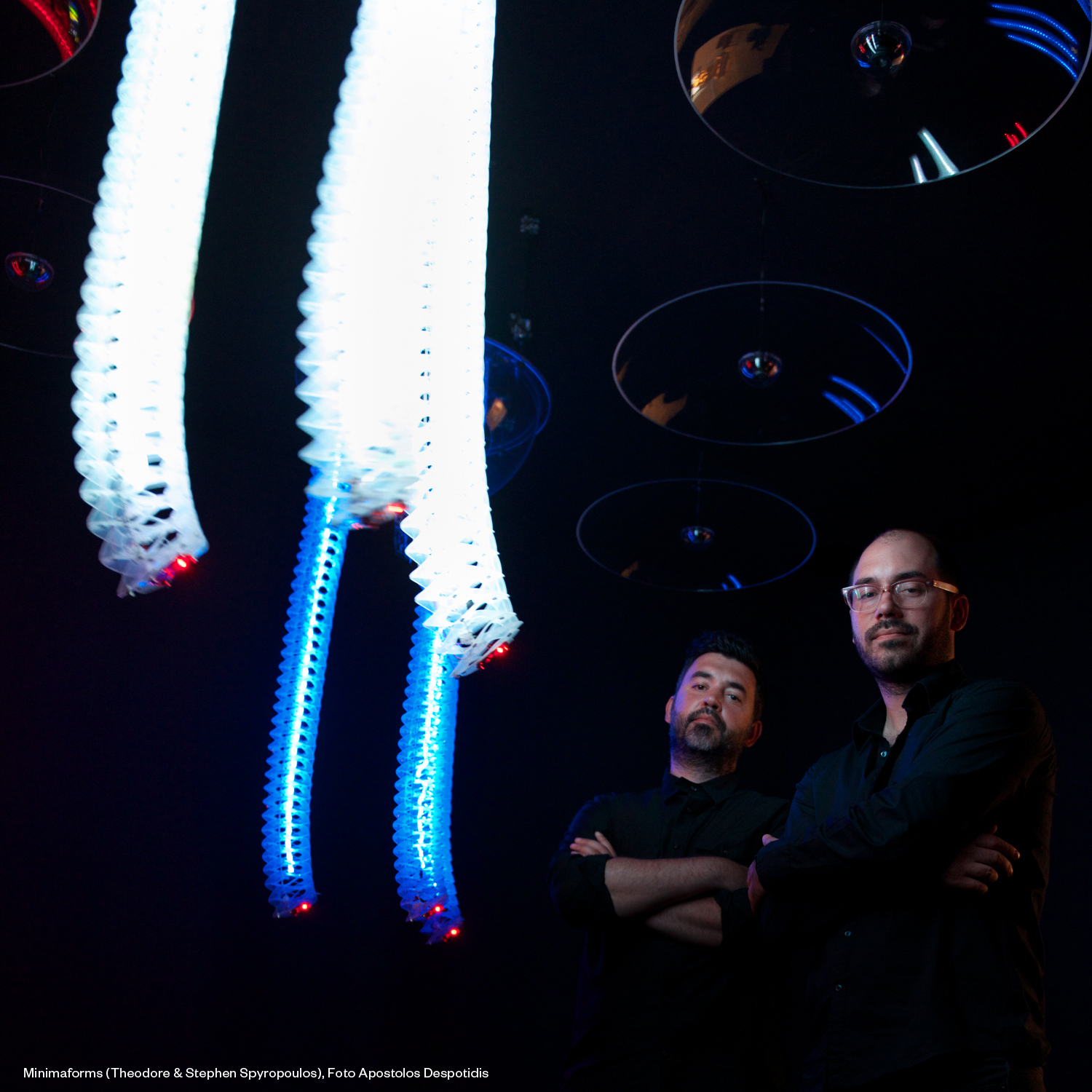Schwebende Roboterarme begrüßen die Besucher/innen am Eingang des Museums. Nähert man sich ihnen, erwachen die Tentakel zum Leben: heben sich, senken sich, drehen und winden sich, bewegen sich wie im Spiel mit den neugierigen Besucher/innen.
„Petting Zoo“, Streichelzoo, heißt die Installation, die mit der Ausstellung Digital Revolution ins DFF eingezogen ist. Die künstlich intelligenten Kreaturen können über Kameras Personen lokalisieren und Aktivitäten erkennen. Indem sie in der Interaktion mit den Besucher/innen Daten sammeln, erlernen sie verschiedene Verhaltensweisen und entwickeln so eigenständige Persönlichkeiten.
„Petting Zoo“ ist ein Projekt des experimentellen Architektur- und Designbüros Minimaforms, das die Brüder Theodore und Stephen Spyropoulos 2002 in London gegründet haben. Minimaforms arbeitet an der Schnittstelle von Kunst, Architektur und Design und erforscht auf künstlerischem Weg Möglichkeiten neuer Formen der Kommunikation.
“Petting Zoo” welcomes the visitors at the entrance of our museum. What kind of reactions to the installation do you wish for?
Theodore & Stephen: Petting Zoo is an immersive AI installation exploring life like attributes through interaction. Three intelligent robotic creatures establish communication with the public creating engagements that can exhibit emotive and sensorial tendencies. These behaviors expressed by the robots evolve over time through human interaction enabling each pet to develop personalities. We wish to see how the pets evolve through the interactions with the Frankfurt community throughout the duration of the installation.
How did the idea for “Petting Zoo” came into being? Which questions did you want to rise with it?
Theodore & Stephen: Petting Zoo continues a pursuit in our practice to explore art and design that enables human engagement. Our projects are speculative questions and arise through an active dialogue that we explore within the public domain. Technology though not foregrounded in our projects becomes a site for interrogation. Following our ephemeral public participatory project Memory Cloud that invited participants to animate the built environment through conversation in London’s Trafalgar Square and in Detroit. We thought to explore our ever-present relationships with artificial intelligence and robotics. Beyond conventions of production and search common to the field we wanted to explore more human engagements and see if we could create creatures that could enable more emotive and evolving human machine engagements.
The exhibition starts with presenting digital devices and works of the past decades before focusing on contemporary works of digital creativity. Which role does the history of digital culture play for your work?
Theodore & Stephen: Petting Zoo is inspired by early computer and systemic experiments such as the seminal cybernetic work such as the Senster developed by the British cybernetic sculptor, Edward Ihnatowicz, Gordon Pask’s The Colloquy of Mobiles, and Walter Gray Walter’s first electronic autonomous robots (Tortoises) called Elmer and Elsie. Certain strands of our work can be said to evolve radical experiments that challenged convention. Our work explores agency and attempts to explore our complex relationship with things.
Do digital works and projects belong in a museum? Which environment do works like yours need to unfold their creative potential?
Theodore & Stephen: As any other cultural artefacts we believe that they do. Our work though utilises digital and analogue technologies does not foreground it. For us what is important is that the work engages the public and utilise art as a means to ask more profound questions of digital culture and our agency within it.
As a film museum we set the focus of the exhibition on the transformation of film through digital technology. Could you imagine a future project of Minimaforms that is related to film?
Theodore & Stephen: Film culture very much embodies narrative and speculation and offers a way to construct scenarios that offers great insight and sensitivity. In works like Petting Zoo we are often asked if we find inspiration in science fiction. For us we live in a time where we believe science fiction has become fact and we are very much engaged in real-time and time-based mediums. In short we would welcome opportunities to explore our work in more filmic means.
The invention and development of works like “Petting Zoo” require both profound technological knowledge and sophisticated technology. How can I as an average user of common digital technologies be digitally creative?
Theodore & Stephen: We believe that projects make demands. When we decide to explore certain ideas we follow them through to their conclusion. We believe in open experimental means to explore work. This means we prototype and explore ideas and their materialization in the world. Creativity is what enables a sustained interest. Working in art today we would only encourage people to explore and interrogate technology. Technology when out in the world cannot be put back into the box. It is our opinion in a society that is ever more technological that art must demystify and explore more human ways to understand and explore their impact. Both Stephen and I were not trained in computer science or robotics and this meant that Petting Zoo evolved over many years of research and exploration. We see it as many of our projects as a continuous experiment altered daily.


